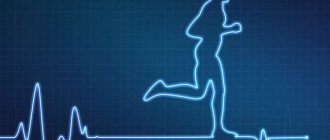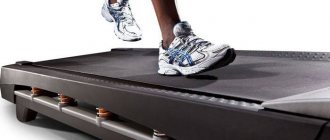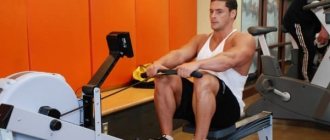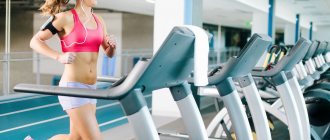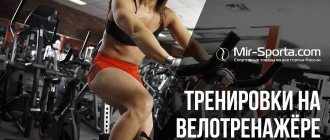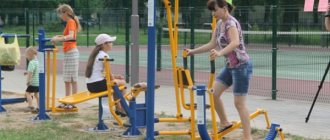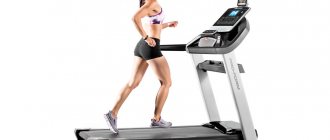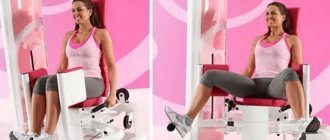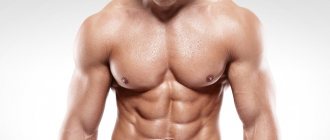American College of Sports Medicine
(American College of Sports Medicine) considers rowing machines "the best equipment in the gym" that allows you to "train all important muscle groups with a smooth and controlled movement." Men's Health magazine says that "rowing machines provide the best full-body workout of any cardio machine because they work both the lower and upper body, leading to enhanced results." Even NASA astronauts use rowing machines because of their effectiveness.
Below are the top 10 benefits of rowing:
Improvement of the cardiovascular system
Like other cardio exercises, rowing forces the heart to pump blood through muscle mass, providing it with energy (oxygen), nutrients, and removing waste products (carbon dioxide and lactic acid). However, rowing has a much greater impact on the described processes, which makes training more effective. The fact is that rowing machines use more muscles.
(according to various sources from 80% to 95%) than on other cardio equipment. More muscles require more energy, which means more blood circulation and heart function. Dr. Levine's work with NASA demonstrates that 30 minutes of rowing can be as effective as 90 minutes of cycling.
In addition, given that the human body is amazingly efficient at adapting to different loads, it is simply useful to vary the load for training. Get off the treadmill, get on the bike, then onto the rowing machine.
Benefits of a rowing machine
- The simulator uses all major muscle groups, which does not happen when exercising on other cardio equipment.
- The training is aimed at increasing overall endurance, both muscles and other functions of the whole body.
- Using the exercise machine, you can reduce body weight; when performing a workout at a fast pace, calories are burned; long-term exercise helps burn subcutaneous fat .
- A rowing machine will improve not only the functioning of the heart, but also the respiratory system.
- The exercise machine improves posture by strengthening the spinal stabilizer muscles.
- Improves mobility of all joints.
- It has no age-related contraindications or restrictions on the musculoskeletal system.
- Able to change the load, adapting to individual needs.
Increased calorie burning
Competitive rowers burn almost twice as many calories over a 2000m race as a steeplechase runner over a 3000m race.
The amazing calorie-burning effect of rowing is due to the large number of muscles involved. Data on the number of calories burned varies due to different training conditions. For example, Harvard Health Publication states that an 84 kg rower burns 377 kcal in 30 minutes. Frederick Hagerman of the physiology lab at Ohio University says rowing burns 10 to 15 percent more calories than cycling. There is evidence that an hour-long session on a rowing machine burns 600 kcal. ShockWave and Indo-Row instructors using WaterRower rowing machines claim that participants in these programs burn an average of 800 calories per hour! Agree that burning 400-800 kcal in less than an hour is amazing.
Common mistakes when performing exercises on a rowing machine
The main mistakes when performing exercises on a rowing machine are :
- Bent back in starting position
- Straight elbows (leads to elbow joint diseases)
- Straight knees (leads to knee joint diseases)
- Bent back (exception is the third phase, when you need to slightly tilt your torso)
- Incorrect rowing sequence on the machine (beginners, having not mastered the technique of performing the exercises, go straight to an intense tempo. Only after learning the movements at a low tempo can they move on to working on a rowing machine at a high tempo).
Full body workout. Increased muscle strength and endurance
The unique thing about rowing is that it allows you to increase both strength and endurance (although endurance, of course, comes first). Through repeated pushing and pulling movements you cause an adaptation in the body, the muscles are forced to perform the effort without corresponding fatigue. By increasing the load over time, you force the muscles to grow, becoming stronger. With consistent exercise, you will also speed up your metabolism. More energy means more opportunities to do what you love!
For those who have never used a rowing machine, it may seem like all the stress falls on your arms and core. In fact, unlike cycling classes, where the load is distributed unevenly (95% on the lower body and 5% on the upper), the distribution of effort in rowing is 60% on the lower body and 40% on the upper
.
At the beginning of the movement, the lower body is involved. The primary muscles here are the quadriceps and the anterior thigh muscles. These muscles are involved in the process of knee extension as well as hip flexion, which allows for powerful movement of the legs. The calf and gluteal muscles are also targeted in rowing.
During the stroke, you flex your hips and core, which appears to engage your abdominal muscles in a similar way to crunches. In fact, the resistance is in the opposite direction, which means that the gluteal muscles, lower back muscles and hamstrings are activated. The abs are engaged during the recovery stage, when you return to the starting position! Regarding the upper body, rowing works the trapezius and rhomboids muscles of the upper back, the latissimus muscles of the lower back, as well as the biceps, triceps and pectoral muscles. In general, rowing movements replicate the mechanics of movements in everyday life, which allows them to be characterized as functional movements.
Rowing technique on a simulator
The technique of rowing on a simulator can be divided into 4 parts: the return phase (recovery phase), the hook or capture phase, the acceleration and movement phase, and the final stroke phase.
Before you start performing exercises, you need to make sure that the belts of the machine are securely fastened. Your heels should fit snugly against the pedals of the machine. The torso is slightly tilted forward, the back is level. When the rowing technique is performed correctly, the muscles of the back, abs of the arms and legs are worked out. By doing exercises at a fast pace, you will burn a lot of calories and increase your endurance.
1 Return phase (recovery phase)
In this phase, the body position turns into a grip. All muscles of the body should be relaxed. The arms remain almost straight. Bend your knees, then straighten your arms completely.
2 Hooking or gripping phase
During rowing in this phase, the main point is body position. If you start the exercise from the wrong position, the muscles will not receive the proper tension. Your arms should be straight and your shoulders should not be at the same level as your hips. The body position is regarded as correct if the main center of gravity is on the legs.
Important : when moving the paddle upward, it is important to remember that the load should go from the legs to the arms. By lowering your arms, as if “raking the water with an oar,” the lateral and trapezius muscles begin to work. When moving into the catch phase, you need to make sure that the movement comes from the hip. In this case, the body must be tilted no more than 30 degrees. Next, you need to tense your torso muscles and evenly distribute the load on your feet. Having fixed your shins vertically, make sure that there is no gap between the body and hips.
3 Acceleration and driving phase
After making sure that your shoulders and arms are straight, you need to firmly fix your feet. Having completed the third part of the stroke, you need to lean back a little with your body. The position of the legs remains unchanged as in the previous phase. Well-executed pushes make it possible to work at an optimal pace. Don't forget about the recovery phase! Bend your elbows and bring your arms toward your lower ribs. The work includes the lateral, brachioradialis, deltoid and biceps muscles.
Important: wrists must remain straight. Also, do not pinch or raise your shoulders.
During the acceleration and driving phases, maximum power is achieved. Starting with your legs (quads and glutes), work your lower back as well as your arms and shoulders (brachioradialis, biceps, rear deltoids, lats, trapezius, rhomboids).
4 The final phase of the stroke
At the moment when the knees are completely straight, the final phase begins. The oars should be at the level of the lower ribs, the muscles of the torso should be tense. The head, neck and shoulders should be relaxed, the elbows should be fixed behind, and the wrists should not be strained.
Some tips for beginners: don't rush into the recovery phase. This leads to the formation of microcracks in the muscles. Pay attention to the grip of the handle. Don't squeeze it too hard. The most correct option would be to softly grip the handle with your fingers. Beginners should choose and follow the correct exercise technique rather than work hard to burn the maximum number of calories. Improper rowing can lead to injuries, sprains and muscle pain. It is important to start exercising on a rowing machine and gradually increase the load and intensity.
Low risk of injury
In rowing, the negative stress on the joints is minimized. Since the rower is in a sitting position, with his feet resting on the stand and his hands holding the handle, there is very little stress on the ankles, knees, hips, elbows and shoulders.
The movement of rowing is the opposite of our daily activity when we are sitting at a computer, typing or driving. This allows rowing to be used as a “cure” against the negative effects of modern lifestyle. Each stroke requires leg press, hip flexion/extension, and shoulder blade retraction (chest opening). We go through a series of movements that increase mobility in the lower back, knee, and shoulder joints.
But rowing is great not only for preventing injuries, but also for those who have already encountered similar problems. For people who are overweight or have joint problems, rowing may be an option. For runners, rowing is an excellent tool for aerobic training, which, however, puts much less wear on the joints that are problematic for runners: knees, ankles, and back. Moreover, if you already have problems with your knees (including surgery) or back, rowing will help you recover. Therefore, it is also used in rehabilitation.
Exercises and training program
The basic complex includes a short and long stroke . The exercises are performed in 3 sets, each with 10–20 repetitions.
Short stroke
Starting position (hereinafter referred to as I.P.): sitting, lower limbs bent at the knee joint, feet secured with belts. Arms extended forward, grip straight. Slowly push off with your feet, move back, and at the end point pull your arms to your chest. Smoothly return to I.P.
You need to exercise slowly to maintain not only the correct technique, but also your health.
Long stroke
IP: as with a short stroke, but the feet are fastened with straps so that the heels are slightly torn off the stop. The back is slightly rounded, the head is pulled forward, the arms are straightened, in a direct grip on the handles.
Choose the right time for training - this should be the period in which you are in the most alert state
Push off with the front of the foot, moving backward, straightening the torso. At the same time, bend your elbows and pull the handle towards your collarbones. Smoothly return to I.P.
The more you straighten your torso when performing the first phase of the exercise, the more your back and abdominal muscles are loaded.
It is recommended to tilt your torso 45 degrees.
Accented triceps training
IP: sit on the seat with your back forward, your legs are placed on the sides of the bench, resting on the floor, bent at the knees. With your arms bent at the elbow joints and behind your head, hold onto the handle. The arms are gradually straightened perpendicularly upward, giving a load to the triceps, then at the same pace they are returned to the starting position.
Targeted development of deltoid muscles
I.P.: standing in front of the simulator, legs spaced shoulder-width apart, back not rounded. The handle is held with palms down. Raise your arms until they form a parallel with the floor surface and lower them.
Training scheme
The content of the training program depends on the athlete’s preparation:
| Level | Training frequency per week (times) | How many approaches | Duration of the approach | Lesson duration (minutes) |
| Beginner (first 14 days) | 2–3 | 3 | 10 short and long strokes each | 15–20 |
| Average | 3 | 3 | 7 minutes | 30 |
| High | 4 | 5 | 10–12 minutes | 40–60 |
Take a 5-10 minute break between approaches. This time is intended for active rest, which involves stretching and light exercises to prevent the muscles from cooling down.
Team or individual work
Rowing can be a great individual or group workout. Many rowing studios are springing up around the world, similar to cycle studios, with energetic instructors, rhythmic music and simple, repetitive movements. This is a great option for those who want all the benefits of rowing but don't want to go it alone.
Well, if you are not a fan of group training, you can train alone in the gym, or buy a rowing machine for home, especially since it is relatively inexpensive.
